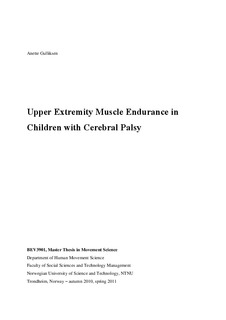| dc.description.abstract | Aim: The aim of this study was to evaluate whether submaximal muscle endurance at 20% of maximal voluntary isometric contraction (MVIC) is as reduced as muscle strength in elbow flexion in children with cerebral palsy (CP), and whether motor unit recruitment to compensate muscle fatigue is hampered in this group.
Methods: Twelve subjects with cerebral palsy and seventeen control subjects performed three MVICs of elbow extension and flexion, and an endurance task holding a load of approximately 20% of MVIC until exhaustion. Both tasks involved either the affected or the non-dominant arm. During the MVICs, elbow extension and flexion torque and surface electromyography (EMG) from biceps brachii, triceps longus and triceps lateralis were collected. During the endurance task EMG from the same three muscles, in addition to accelerometer and inclinometer data were collected.
Results: The CP group produced some lower torque and significant lower agonist EMG amplitudes during MVIC compared to the control group. The holding time to exhaustion was similar in the two groups. The CP group did not increase EMG amplitudes during this task, while the control group did. This difference between the two groups was significant. The median frequency (MDF) from start to end of the endurance task decreased on average 50% less in the CP group, but this difference between the two groups was not significant. Standard deviation (SD) of angle increased from start to end in both groups, increasing significantly more in the control group. SD of acceleration increased significantly in both groups, increasing more in the control group.
Conclusion: The CP and the control group carried out the endurance task to exhaustion. The CP and the control group had similar holding time at the same relative load during the endurance task indicating muscle endurance was similar affected as muscle strength in children with CP. Agonist muscle activity during the endurance task did not increase in the CP group. Consequently, the CP subjects were not able to recruit additional motor units and had relatively lower levels of muscle fatigue.
Key words: Cerebral palsy, MVIC, endurance, 20% of MVIC, holding time, EMG, biceps brachii, motor unit recruitment, muscle fatigue. | nb_NO |
